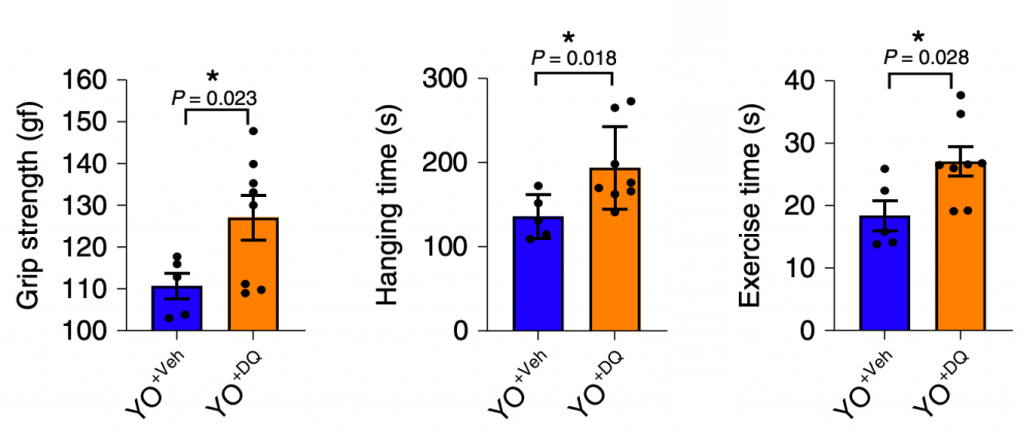Key Points:
- Blood from older adults induces senescence — a cellular state known to underlie the aging process — in human cells.
- In addition to inducing senescence, transferring blood from old to young mice leads to premature aging of the liver, kidneys, and muscle.
- Senolytics — drugs that eliminate senescent cells — reverse liver, kidney, and muscle aging while restoring physical strength and endurance.
Aging science researchers generally agree that senescent cells (SnCs) are a major driver of aging. Now, investigators from the Buck Institute for Research on Aging report findings supporting this idea in the latest issue of Nature Metabolism.
“Cellular senescence is a response to stress and damage that increases with age. SnCs enter a permanent growth arrest and release senescence-associated secretory phenotypes (SASP),” state the authors of the report.
The SASP, or SASP factors the authors speak of include pro-inflammatory molecules that can damage our cells, tissues, and organs, which over time may develop into age-related diseases. SASP factors also include molecules that induce senescence in healthy cells, thus spreading the abundance of senescent cells and elevating SASP factor levels.
By spreading SASP factors, the Buck researchers demonstrate that old blood can induce senescence (elevated senescent cells and SASP factors) in human cells and young mice, leading to muscle, liver, and kidney dysfunction. Furthermore, it is demonstrated that the spread of senescence and organ dysfunction can be partially reversed by treatment with senolytic compounds — molecules that selectively remove senescent cells.
Old Blood Induces Senescence and Aging
Jeon and colleagues carried out experiments at the Buck Institute, UC Berkley, and Korea University College of Medicine. They took plasma, the liquid portion of blood, from older individuals or younger individuals and exposed human kidney cells to the plasma. Results showed that kidney cells exposed to old plasma had a higher percentage of senescent cells and more SASP factors than kidney cells exposed to young plasma.

To determine how transferring senescence through old blood could affect aging, Jeon and colleagues removed blood from old (equivalent to about 70 human years) mice with a syringe and transferred it to young (equivalent to about 26 human years) mice intravenously (heterochronic blood exchanges). Transferring blood from the old to young mice led to an increase in senescence, namely in the liver, kidney, and muscle. Blood transfer also led to the dysfunction of these organs, including muscle weakness, liver scarring, and kidney damage.

Senescence and Aging Reversed by Senolytics
With the importance of senescent cells and their role in aging coming to fruition, research on senolytic compounds (senescent cell killers) and how they can be used to treat aging and age-related diseases has been on the rise. The senolytic combo dasatinib and quercetin (DQ), and ABT263 (navitoclax) are commonly tested in aging studies. DQ has been shown to counter age-related muscle weakness, accelerate bone healing, and enhance muscle regeneration, while ABT263 has been shown to improve age-related memory loss.
To test the effect of these senolytic compounds on aging, Jeon and colleagues treated old mice with DQ or ABT263 before transferring their blood to young mice. The researchers found that both senolytic treatments reduced muscle, liver, and kidney senescence, as well as liver scarring, and kidney damage in the young mice. In muscle, DQ restored grip strength, hanging time, and exercise time in the young mice, demonstrating improved physical strength and endurance.

Senolytics the Cure for Aging?
While the FDA does not yet consider aging a disease, much of the aging science points to it as such. For example, animal studies show that several interrelated processes underly nearly all age-related diseases with each disease associated with the aging/deterioration of a particular organ like the brain (neurodegenerative disease), muscle (sarcopenia), or heart (heart disease). One of these underlying processes is the induction and spread of senescence, which promotes organ deterioration. It’s widely accepted that senescent cells exist mainly to decrease the probability of cancer growth, so researchers still need to find ways to safely remove senescent cells from the body without adverse health effects. Still, senolytic compounds for the treatment or prevention of age-related diseases seem like a promising avenue.